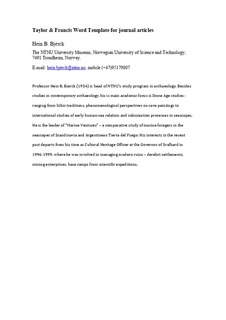| dc.contributor.author | Bjerck, Hein Bjartmann | |
| dc.date.accessioned | 2019-08-08T10:31:09Z | |
| dc.date.available | 2019-08-08T10:31:09Z | |
| dc.date.created | 2019-08-07T13:34:47Z | |
| dc.date.issued | 2019 | |
| dc.identifier.citation | Environmental Archaeology. 2019, . | nb_NO |
| dc.identifier.issn | 1461-4103 | |
| dc.identifier.uri | http://hdl.handle.net/11250/2607571 | |
| dc.description.abstract | ‘Climate’ is rarely experienced directly – contrary to day-to-day ‘weather’ and ‘seasons’ that manifest in landscapes (‘weather-worlds’). This paper elaborates the role of sea ice and sea ice hunting outside the lateglacial Doggerland beaches. The winter–spring sea ice was a seasonal extension of the continental plains, and a potential meeting ground for the human hunters of the plains and the mammals of the sea. Here, the hunters could observe and experience that seals were easy prey and that seals were similar to the familiar terrestrial megafauna; providing meat and blood, bone, skin, bladders and sinews, and ample supplies of fat (blubber) that also could heat dwellings. Seals on the ice could be hunted with similar methods and equipment as terrestrial animals – without the need of boats and the risks of cold, open sea. The Doggerland sea ice was a meeting ground of land and sea that could have been imperative in the development of marine foraging and the subsequent colonisation of Scandinavian seascapes. Levi Bryant’s ‘Machine Oriented Ontology’ may be instrumental to envision the sea ice and its potential for the lateglacial hunters in Northwest Europe. | nb_NO |
| dc.language.iso | eng | nb_NO |
| dc.publisher | Taylor & Francis | nb_NO |
| dc.title | What could the ‘sea ice machine’ do to its people? On the lateglacial Doggerland, marine foraging, and the colonisation of Scandinavian seascapes | nb_NO |
| dc.type | Journal article | nb_NO |
| dc.type | Peer reviewed | nb_NO |
| dc.description.version | acceptedVersion | nb_NO |
| dc.source.pagenumber | 13 | nb_NO |
| dc.source.journal | Environmental Archaeology | nb_NO |
| dc.identifier.doi | https://doi.org/10.1080/14614103.2019.1642673 | |
| dc.identifier.cristin | 1714632 | |
| dc.relation.project | Norges forskningsråd: 208828 | nb_NO |
| dc.description.localcode | Locked until 23.1.2021 due to copyright restrictions. This is an [Accepted Manuscript] of an article published by Taylor & Francis in [Environmental Archaeology] on [23 Jul 2019], available at https://doi.org/10.1080/14614103.2019.1642673 | nb_NO |
| cristin.unitcode | 194,31,5,0 | |
| cristin.unitname | Institutt for arkeologi og kulturhistorie | |
| cristin.ispublished | true | |
| cristin.fulltext | postprint | |
| cristin.qualitycode | 2 | |
